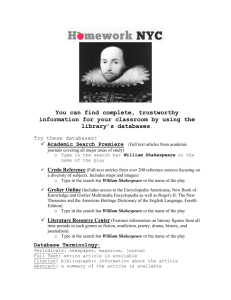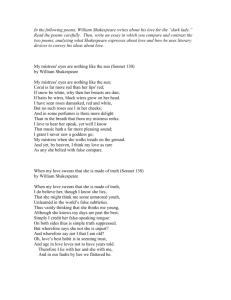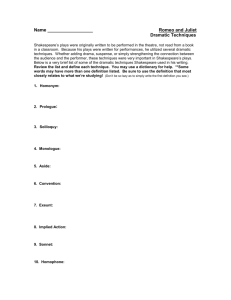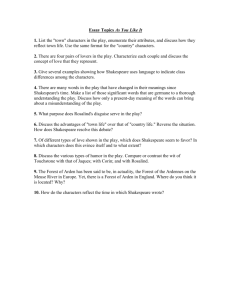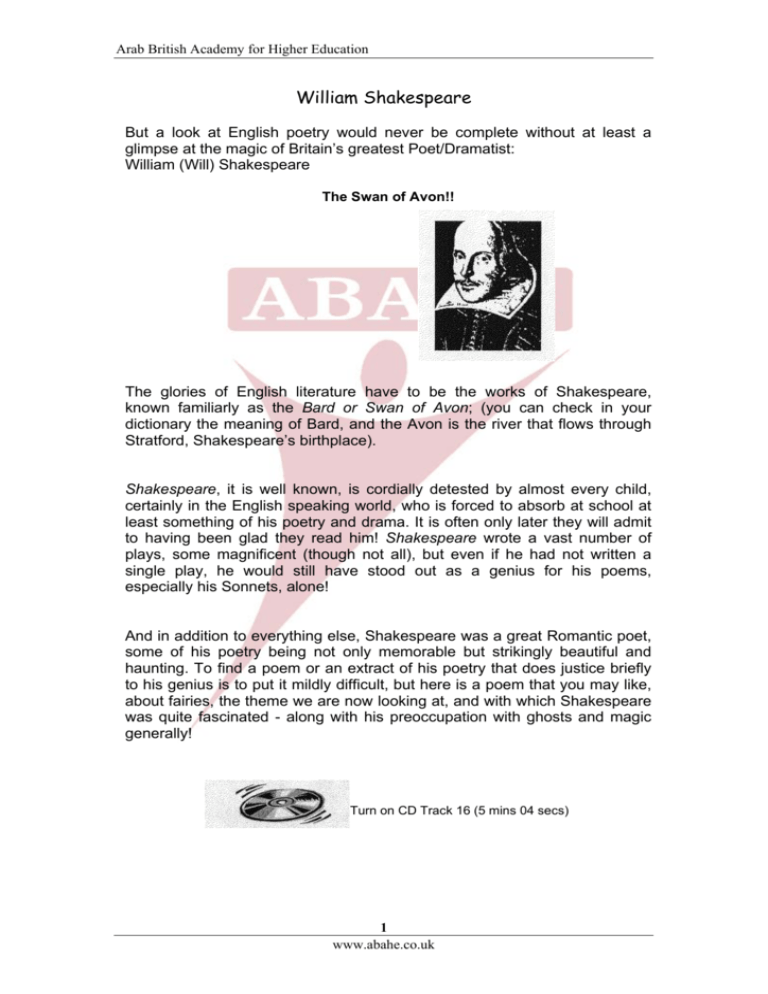
Arab British Academy for Higher Education
William Shakespeare
But a look at English poetry would never be complete without at least a
glimpse at the magic of Britain’s greatest Poet/Dramatist:
William (Will) Shakespeare
The Swan of Avon!!
The glories of English literature have to be the works of Shakespeare,
known familiarly as the Bard or Swan of Avon; (you can check in your
dictionary the meaning of Bard, and the Avon is the river that flows through
Stratford, Shakespeare’s birthplace).
Shakespeare, it is well known, is cordially detested by almost every child,
certainly in the English speaking world, who is forced to absorb at school at
least something of his poetry and drama. It is often only later they will admit
to having been glad they read him! Shakespeare wrote a vast number of
plays, some magnificent (though not all), but even if he had not written a
single play, he would still have stood out as a genius for his poems,
especially his Sonnets, alone!
And in addition to everything else, Shakespeare was a great Romantic poet,
some of his poetry being not only memorable but strikingly beautiful and
haunting. To find a poem or an extract of his poetry that does justice briefly
to his genius is to put it mildly difficult, but here is a poem that you may like,
about fairies, the theme we are now looking at, and with which Shakespeare
was quite fascinated - along with his preoccupation with ghosts and magic
generally!
Turn on CD Track 16 (5 mins 04 secs)
1
www.abahe.co.uk
Arab British Academy for Higher Education
Over Hill, Over Dale
Over hill, over dale
Thorough bush, thorough brier
Over park, over pale
Thorough flood, thorough fire,
I do wander everywhere,
Swifter than the moonè’s sphere,
And I serve the fairy queen,
To dew her orbs upon the green:
The cowslips tall her pensioners be;
In their gold coats spots you see;
Those be rubies, fairy favours,
In those freckles live their savours:
I must go seek some dew-drops here,
And hang a pearl in every cowslip’s ear.
Midsummer Night’s Dream
We will have a look at another of Shakespeare’s poems -his plays all have
poems and songs; Over Hill, Over Dale came from A Midsummer Night’s
Dream...
The next poem is from Much Ado About Nothing, and deals with yet another
familiar theme, men’s inconstancy or unfaithfulness:
Sigh No More, Ladies
Sigh no more, ladies, sigh no more,
Men were deceivers ever,
One foot in sea and one on shore,
To one thing constant never;
Then sigh not so, but let them go,
And be you blithe and bonny,
Converting all your sounds of woe
Into Hey nonny, nonny.
Sing no more ditties, sing no moe,
Of dumps so dull and heavy;
The fraud of men was ever so,
Since summer first was leavy:
Then sigh not so, but let them go,
And be you blithe and bonny,
Converting all your sounds of woe
2
www.abahe.co.uk
Arab British Academy for Higher Education
Into Hey nonny, nonny.
Much Ado About Nothing
The last Shakespeare poem we shall show here is one of his best known
and greatest Sonnets, a wonderful example of his view not only of women
(or one woman?) but his own self estimation; did he know when he wrote his
works the extent to which he would be revered in future centuries? I think he
might have done...
Shall I Compare Thee to a Summer’s Day (Sonnet XVIII)
Shall I compare thee to a summer’s day?
Thou art more lovely and more temperate:
Rough winds do shake the darling buds of May,
And summer’s lease hath all too short a date:
Sometime too hot the eye of heaven shines,
And often is his gold complexion dimmed;
And every fair from fair sometime declines,
By chance, or nature’s changing course untrimmed;
But thy eternal summer shall not fade,
Nor lose possession of that fair thou owest,
Nor shall Death brag thou wanderest in his shade,
When in eternal lines to time thou growest;
So long as men can breathe, or eyes can see,
So long lives this, and this gives life to thee.
So there you have a cross section of styles both Ancient and Modern based
on the Poems. Summing up, here is what you should look for:
a)
Rapunzstiltskin: This is a modern poem written by Liz Lochhead, a Scottish
poet, very independent in approach, and a free spirit representing strongly
the Modern or New Woman...
She follows the style of Angela Carter and Roald Dahl, in taking fairy tales
and sending them up, e.g. Rapunzel and Rumpelstiltskin are the main
legends, with Little Red Riding Hood: ( ‘all the better to see you with...’ as
the girl takes off her glasses... ) to back them up.
Her poem is in a free verse style, no rhyme, an irregular line length, very
conversational. It has a lot of colloquial words you may need to look up; e.g.
gingerbread, chignon, shimmying. (See the next Activity which has
questions on these...)
It is what one might call anti-romantic, for example the rescuing Prince has
feet of clay, and gets all the ‘wrong answers’, in fact he generally disappoints
3
www.abahe.co.uk
Arab British Academy for Higher Education
the young lady, with in the end - for her - fatal results... Rapunzstiltskin is a
poem meant to be read aloud so you can hear a version of it on your CD.
b)
Shakespeare: i) Over Hill, Over Dale: this is a traditional Fairy Tale in the
true sense; it is taken from one of Shakespeare’s most light hearted and
agreeably romantic comedies, A Midsummer Night’s Dream..
Here the fairy, the servant and messenger of Titania, Queen of the Fairies,
describes what she does, in Shakespeare’s most lyrical and delightful style,
mixing beautifully natural and magical images to provide a confection of
escapist fantasy; wonderful! You might need to look up ‘pensioners’ which is
not what it appears... The poetic style is traditional with rhyme (mostly
couplets) and a free very regular beat and line length... Easy to read especially aloud - and to understand!
b)
Shakespeare ii) Sigh No More, Ladies
This ballad, usually sung to a lute, comes from one of Shakespeare’s
brightest comedies, Much Ado about Nothing, famous for the romantic
sparring of Beatrice and Benedick, the unwilling lovers.
In this song, Balthasar the minstrel sings of men’s inconstancy, but it is a
ballad of acceptance where the ladies are advised to be ‘blithe and bonny’
and convert all their woes to: ‘Hey nonny, nonny’: (Does it really matter in the
end? a wise philosophy, perhaps...)
The style is simple and conventional, and the song consists of two stanzas
(verses) of eight lines each, divided into two quatrains (stanzas of four lines),
and the rhyme scheme is called alternate: e.g.. more - ever; shore, never...
The ballad has the feature in common with Rapunzstiltskin, that men are just
frail beings, but here the mood is philosophical and benign, whereas in Liz
Lochhead’s poem there is a certain bitter cynicism heralding the unfortunate
end to her heroine... Shakespeare in Sigh no More, Ladies is not bitter, but
bittersweet...
iii) Shakespeare: Sonnet xviii
Shall I Compare Thee to a Summer’s Day?
It was Shakespeare, as one might have guessed, who invented the
Shakespearean Sonnet, those wonderful fourteen line poems, complete
entities in themselves, the later musical equivalent of which is the Sonata...
The Shakespearean Sonnet is in two parts, three Quatrains (Four Line
Stanzas), ending with a Couplet. One very interesting characteristic of the
Sonnet is that whatever the Beat (or Scansion), there are invariably ten
syllables to each line: in fact ten seems to be the magic number of syllables
in most poetic lines of Shakespeare and his contemporary poets...
4
www.abahe.co.uk
Arab British Academy for Higher Education
It is generally recognized that this is one of Shakespeare’s greatest Sonnets,
whose apparent simplicity disguises its wealth of meaning and subtlety. It
reminds me of the first line of one of Shakespeare’s great Histories, Richard
III ‘Now is the Winter of our Discontent...’ (again ten syllables) which is being
forever quoted...
But whereas Richard’s soliloquy heralds a long pageant of violence and
bloodshed, this Sonnet gives us Shakespeare in a more relaxed and benign
mood, there are shadows (of course) but these are here dominated by
warmth and friendliness.
This is a Love Poem with its most positive aspects, it dismisses the sun as
unreliable and often hostile:
‘Sometime too hot the eye of heaven shines,
And often is his gold complexion dimmed.’
and states that this person’s beauty (whose?) is the only thing in this world
that will last:
‘But thy eternal summer shall not fade...’
In the end Shakespeare shows his overall humanity - which will not let him
resist the temptation of indulging in Vanity, or would it be kinder to call it
Accurate Self Assessment?
‘So long as men can breathe, or eyes can see
So long lives this, and this gives life to thee.’
Shakespeare is saying that his Sonnet will always be read (as long as men
can read...) and through it, the beauty of the person addressed will be seen.
By implication through his words, his Love will also continue to live; what
else is there to say? We are back to the Bible and the immortality of the
Word...
Turn on CD Track 17 (1 min 34 secs)
After considering Poems both traditional and modem, here is Activity Three
which will allow you to practise what we have been looking at:
5
www.abahe.co.uk
Arab British Academy for Higher Education
Answer the Following Questions on the Poems:
Activity 3
1)Rapunztiltskin
What is the meaning of the following: i) gingerbread ii) chignon
iii) shimmying
Explain the connection between Rapunzel and Rumpelstiltskin
Why did the lady take off her glasses?
What answer did she expect?
) Over Hill, Over Dale
What is the work of the Fairy (the Narrator)?
What is meant by: i) dew her orbs ii) her pensioners?
) Sigh no More, Ladies
Give briefly in your own words (about 50 words) the message behind
this Song.
What is meant by:
One foot in sea and one on shore
Hey nonny, nonny
) Shall I Compare Thee to a Summer’s Day?
What is meant by:
)
A summer’s day
The darling buds of May
The eye of heaven
Every fair from fair sometime declines
By chance or nature’s changing course untrimmed
5) All Four Poems
What have the Poems in common? (about 50 Words)
How do they differ? (About 50 Words)
Liz Lochhead appears more realistic than Shakespeare; how
realistic do you think Shakespeare is?
Make a comparison in the view of love between Rapunzstiltskin and
Shakespeare’s Sonnet XVIII
6
www.abahe.co.uk
Arab British Academy for Higher Education
You have the Key to these Activities following this Lesson; in some cases
this can only be a guide, but it will help if you compare your own answers
with those of the Key.
The Tutor-marked Assignment follows after this Lesson and the Key; please
check carefully all the Activities before you go on to it, and if you are
bothered about the Poems or the Suggestions and Answers in the Key, you
can refer to your Tutor who will be pleased to help you. The very best of luck
in your Tutor-marked Assignment!
All Rights Reserved © Arab British Academy for Higher Education
7
www.abahe.co.uk


